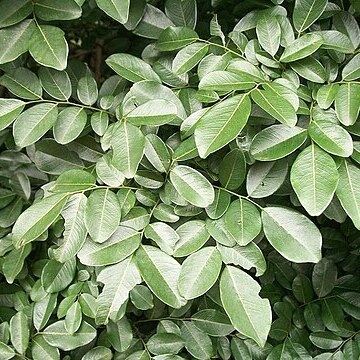Often an unarmed woody climber, with young twigs twining around the surrounding vegetation, but can become a small tree up to 6 m in height. Bark: grey and rough when old; young growth zigzagging slightly. Leaves: with 5-9 sub-opposite to alternate leaflets; leaflets oval to obovate, up to 6 x 3 cm but usually smaller, hairless, dark green above, paler blue-grey below, midrib and veins prominent; apex and base tapering or rounded; margin entire, wavy; petiole with velvety brown hairs; stipules about 6 mm long, falling early. Flowers: small, creamy white, sweetly scented, in dense branched heads up to 10 cm long. Fruit: a narrow, flat, oblong pod, up to 9 x 1.8 cm, the seed-case thickened and heavily and conspicuously veined, indehiscent; sometimes developing as an ovoid gall.
Small tree or shrub, often scandent with modified, tendril-like branches. Leaves 75-125 mm long. Leaflets 2-4 on either side of rachis; upper surface glabrous; lower surface appressed-pubescent to subglabrous. Stipules 4-7 mm long, caducous. Inflorescences terminal and axillary panicles on leafy branches, 40-200 mm long, many-flowered. Flowers white. Calyx 3.0-4.5 mm long. Petals 5-8 mm long; wings shorter than standard and ± as long as keel, fragrant. Flowering time Oct., Nov. Pod elliptic-oblong; 1-3-seeded.
Leaves up to 12 cm long; petiole 0.6–1.5 cm long, rachis 3–7 cm long, puberulous-glabrescent; petiolules 1.5–3.5 cm long; leaflets (2)3–4 on each side of the rachis, 1.5–4.5 × 0.8–2.8 cm, obovate to elliptic, rounded or obtuse or acute at the apex, occasionally emarginate, rounded to obtuse at the base, undulate on the margin, glabrous on upper surface, sparsely puberulous beneath; lateral nerves in 6–10 pairs, visible on both surfaces; stipules 4–6 mm long, subfalcate-acute, early-caducous.
Foliis trijugis, foliolis obovato-oblongis acutiusculis glabris, petiolis paniculisque terminalibus axillaribus que velutinis, leguminibus utrinque acutis ferrugineo pubescentibus. Sed foliola supra medium paulo latiora acutiora. Flores non vidi. Leguimna 1-2-rarissime 3-sperma, ad semina valde rugosa. Summitates pro more generis saepe subvolubiles.
Standard 5–6 mm long including the claw c.1.5 mm long, subpandurate; wings as long as the standard, auricle obsolete, claw 2 mm long; keel petals slightly shorter than the wings, dorsally connate-cucullate at the apex, claw 2.5 mm long.
Pod flat, 1–2-seeded, 3.5–7 × 1.2–1.8 cm, thin, stiff, fulvous, subsericeous, attenuate subacute at the apex, rounded to subacute or cuneate at the base, moderately thickened and raised-reticulate over the seeds.
Small tree or scrambling shrub 3–5 m high or an unarmed climber or liane to 30 m high reaching the canopy, often with side branches on older wood becoming hooked or coiled and tendril-like.
Calyx 3.5–4.5 mm long, appressed-puberulous or subtomentellous; upper teeth shallow-rounded, the lateral ones 1–1.5 mm long, obtuse, the lower one 2–2.5 mm long, oblong-ovate or acute.
Inflorescence of axillary and terminal panicles 3–10 cm long, often somewhat scorpioid, minutely fulvous-pubescent; bracts and bracteoles small, present at anthesis.
Ovary 2–3-ovulate, pilose on the midrib and suture; style 1 mm long, glabrous; stipe c.2 mm long, puberulous.
Flowers white, scented, 6–7 mm long, congested; pedicels up to 1 mm long or flowers sessile.
Stamens all connate in a single bundle or in 2 bundles of 5.
Young parts minutely tomentose or puberulous.
Seed 9 × 5 × 1.5 mm; testa brown, glossy.


